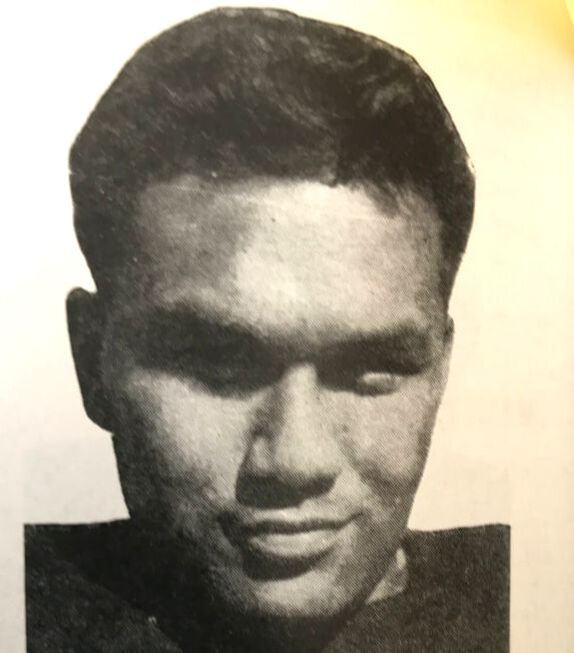A 1936 Shooting Russell Cahill © 12/2019
Corvallis, Oregon – December 6, 2019
The rooming house at 128 - 9th St. S.W. where my father was shot, was torn down a year or so ago, leaving the entire 100 block bare and ready for a development advertised on one of those big blue Planning Department signs. Whatever is to replace the building that housed Oregon State College students in 1936 will find the old basements filled in with gravel.
It was from the basement of the building owned by Mr. and Mrs. Moss King that at around 6:30 P.M. on December 17th, 1936, Clyde Ellis, Mrs. King’s 14-year-old son from a previous marriage, obtained a 12-gauge double gun, returned to the first floor, shot Bill Cahill twice, set the gun by the door and ran off.
Classes had ended and finals taken. Bill Cahill, a native Hawaiian who had emigrated from the Territory at age 5, had transferred from San Mateo Junior College during the summer, and according to The Oregon State Monthly Magazine, he was considered the most valuable transfer player on the Beaver varsity football team. His dream was to study pre-medicine and to attend medical school and become a physician. His ticket for the train ride home to San Francisco for the holidays sat on the dresser in his room.
Bill’s dream of becoming a physician was not to be. According to articles in the Corvallis Gazette-Times and the Daily Barometer, the shooting allegedly resulted from an argument. During dinner, Mrs. King scolded Clyde for coming to dinner in a filthy and smelly sweatshirt. The boy was said to have cursed out his mother, and Bill asked him to calm down and come upstairs to talk it over. The talk turned ugly and, according to Bill, he slapped the boy. They returned to the table. Clyde said he was going downtown and left by the front door.
Instead of downtown, the boy entered the basement, loaded a shotgun and returned to the dining room where he fired the first barrel at Bill. That blast tore through Bill’s back, ribs and hip area, opening a large wound and knocked him to the floor. Although bleeding profusely, Bill was able to run to another room and Clyde followed. As the boy prepared to shoot again, Bill grabbed a large chair and threw it at him. The second shot went through the bottom of the chair and hit Bill in his right arm.
Chief of Police Earl Humphrey was first on the scene of the shooting and a search was begun to find Clyde while an ambulance took Bill Cahill to Corvallis General Hospital where his wounds were cleaned and stitched. According to Bill, he was loaded into a Pullman car on a gurney and shipped to San Francisco where he was able to heal up over a period of weeks. His grant-in-aid for playing football disappeared as did his chance at a college education.
At around six feet tall, Clyde Ellis looked older than he was. He took Bill Cahill’s train ticket and disappeared. After travelling south, Clyde Ellis hitchhiked around the country. According to newspaper accounts, he believed he had killed Bill Cahill and 10 months later surrendered himself to authorities in New York. Upon his return to Oregon, he was tried and convicted of assault with intent to commit murder and sentenced to 6 years in the state penitentiary. Considering his age, the judge paroled him to his birth father in Portland for the 6-year term. The last known record of him was an obituary of his death in Yuma Arizona in 2000.
Bill Cahill got well, married my mother Dorothy Hutchinson and raised a family of 6 children. He became a seaman, served as a Lieutenant in the Merchant Marine during World War II, tried to make it in a couple of business ventures and returned to sea as a chief engineer on American President Lines ships. During my youth, I recall seeing the big 6 inch by 3 inch scar on his lower back and the scar in the triceps of his right arm. On occasion, a piece of lead shot would work its way to the surface of his body after migrating a couple of feet from its origin and he would have it removed and cleaned up. His chest X-rays were spectacular.
One of the points proffered by advocates for gun control is that firearms should be secured; particularly in homes with children. From Columbine to Sandy Hook, terrible events have occurred when unstable teen boys get it in their head to exercise their aggression through the barrel of a gun. It was as true in 1936 as it is today.
Source Material
Corvallis Gazette-Times Dec. 18,1936
Corvallis Gazette-Times Oct. 16, 1937
The Barometer Dec. 1936
Oregon State Yearbook 1936- 1937
Recollections of conversations with my father
With thanks to the Archivists at Valley Library, Oregon State University

 RSS Feed
RSS Feed